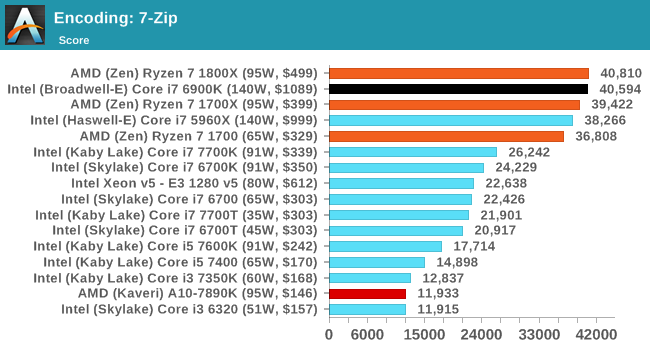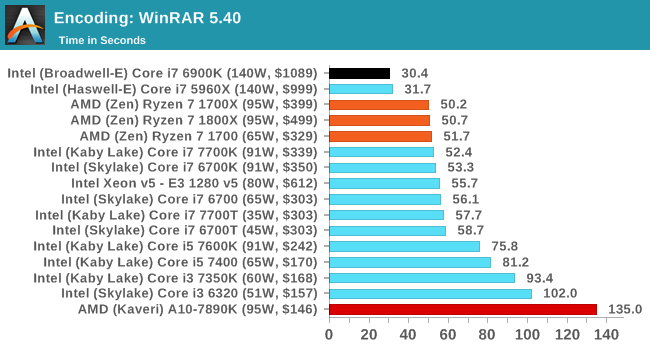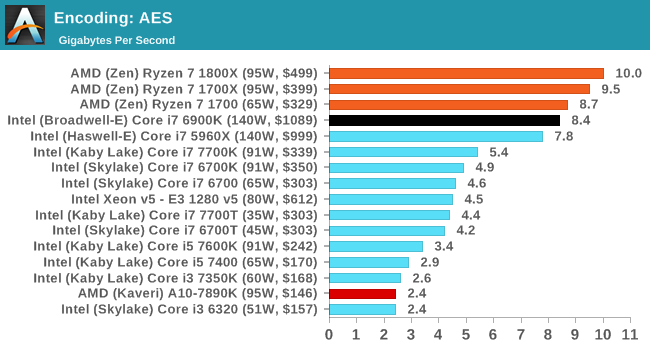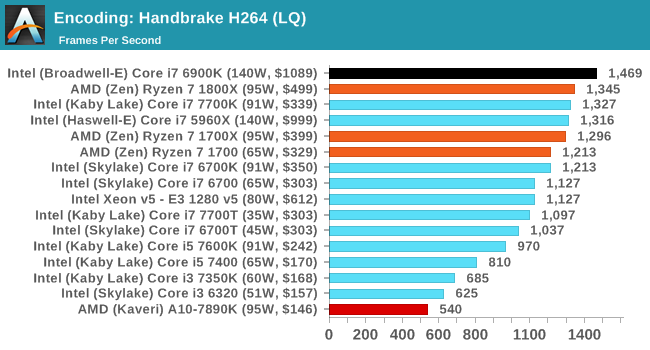The AMD Zen and Ryzen 7 Review: A Deep Dive on 1800X, 1700X and 1700
by Ian Cutress on March 2, 2017 9:00 AM ESTBenchmarking Performance: CPU Encoding Tests
One of the interesting elements on modern processors is encoding performance. This includes encryption/decryption, as well as video transcoding from one video format to another. In the encrypt/decrypt scenario, this remains pertinent to on-the-fly encryption of sensitive data - a process by which more modern devices are leaning to for software security. Video transcoding as a tool to adjust the quality, file size and resolution of a video file has boomed in recent years, such as providing the optimum video for devices before consumption, or for game streamers who are wanting to upload the output from their video camera in real-time. As we move into live 3D video, this task will only get more strenuous, and it turns out that the performance of certain algorithms is a function of the input/output of the content.
7-Zip
One of the freeware compression tools that offers good scaling performance between processors is 7-Zip. It runs under an open-source licence, is fast, and easy to use tool for power users. We run the benchmark mode via the command line for four loops and take the output score.

WinRAR 5.40
For the 2017 test suite, we move to the latest version of WinRAR in our compression test. WinRAR in some quarters is more user friendly that 7-Zip, hence its inclusion. Rather than use a benchmark mode as we did with 7-Zip, here we take a set of files representative of a generic stack (33 video files in 1.37 GB, 2834 smaller website files in 370 folders in 150 MB) of compressible and incompressible formats. The results shown are the time taken to encode the file. Due to DRAM caching, we run the test 10 times and take the average of the last five runs when the benchmark is in a steady state.

AES Encoding
Algorithms using AES coding have spread far and wide as a ubiquitous tool for encryption. Again, this is another CPU limited test, and modern CPUs have special AES pathways to accelerate their performance. We often see scaling in both frequency and cores with this benchmark. We use the latest version of TrueCrypt and run its benchmark mode over 1GB of in-DRAM data. Results shown are the GB/s average of encryption and decryption.

HandBrake H264 and HEVC
As mentioned above, video transcoding (both encode and decode) is a hot topic in performance metrics as more and more content is being created. First consideration is the standard in which the video is encoded, which can be lossless or lossy, trade performance for file-size, trade quality for file-size, or all of the above can increase encoding rates to help accelerate decoding rates. Alongside Google's favorite codec, VP9, there are two others that are taking hold: H264, the older codec, is practically everywhere and is designed to be optimized for 1080p video, and HEVC (or H265) that is aimed to provide the same quality as H264 but at a lower file-size (or better quality for the same size). HEVC is important as 4K is streamed over the air, meaning less bits need to be transferred for the same quality content.
Handbrake is a favored tool for transcoding, and so our test regime takes care of three areas.
Low Quality/Resolution H264: He we transcode a 640x266 H264 rip of a 2 hour film, and change the encoding from Main profile to High profile, using the very-fast preset.

High Quality/Resolution H264: A similar test, but this time we take a ten-minute double 4K (3840x4320) file running at 60 Hz and transcode from Main to High, using the very-fast preset.

HEVC Test: Using the same video in HQ, we change the resolution and codec of the original video from 4K60 in H264 into 1080p30 HEVC. This causes a dramatic reduction in filesize.











574 Comments
View All Comments
Notmyusualid - Sunday, March 5, 2017 - link
@ prisonerXPossibly, but with dollars in our pockets, that others want. Hence this product release.
prisonerX - Sunday, March 5, 2017 - link
Yes, obviously this product release was just for gamers. Thank you for proving my point.Notmyusualid - Monday, March 6, 2017 - link
You are most welcome!divertedpanda - Saturday, March 4, 2017 - link
I doubt gamers make a majority of the people who can afford $150+ CPUs... Content Creators/Prosumers probably make the bank for these kind of purchases....Notmyusualid - Monday, March 6, 2017 - link
@ Meteor2I do too.
nobodyblog - Friday, March 3, 2017 - link
AMD claimed that Every core is really one core, but now, we know it is at least two cores, because everything is more...It won't be able to be well in different scenarios specially in less threads and even gaming. I doubt their patch works.. It is very bad in IPC, and performance wise it is a garbage in 16 nm...
Thanks!
Thanks!
nobodyblog - Friday, March 3, 2017 - link
I mean 14 nm FinFet..charliebi - Friday, March 3, 2017 - link
want to setup a gaming rig? Buy a 7700K, or better save something and buy a 7500 or 7600 and put the savings on a gtx 1080 ti. That's all gamers need to know.007ELmO - Friday, March 3, 2017 - link
what if I want to build 4 gaming rigs for a LAN? does the 1080ti and AMD chip run under 500W power requirement?Outlander_04 - Saturday, March 4, 2017 - link
Gamers , like everyone else, need to buy using their brains and not prejudices.First up decide if you are going to use a 1080p/ 60 Hz monitor . If you are then you do not need either an i7 7700 or a 1080ti .
If you want that resolution and you have a 144 hz monitor then there is a case for using an intel quad.
If you are gaming at 4K, 1440p or with a high resolution ultra wide then Ryzen will also do the job very well and be a far better encoder. For those users the AMD chip looks to be very very good v
value